Software Development Life Cycle (SDLC) Definition
The SDLC is a model utilized to create, implement, and sustain software applications. The SDLC involves a comprehensive strategy outlining the procedures for creating, updating, replacing, modifying, or improving particular software in a detailed manner.
The framework standardizes the process into six to eight stages, aiming to enhance software quality by being attentively process-centric. The purpose of formalizing the steps is to enable measuring and analyzing progress and expenses, which can then be utilized for making improvements and monitoring the overall development process.
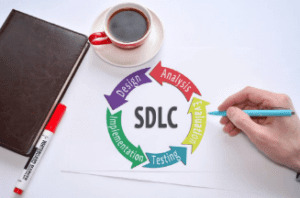
Software Development Life Cycle
This graphic illustrates the different phases that are typically involved in a standard SDLC. The standard stages of a Software Development Life Cycle include the following:
The Software Development Cycle
A life cycle model for software represents the necessary methods to be used during each stage of a software product’s development process. This model also outlines the structure for executing these methods.

The Software Development Cycle
In simpler terms, a life cycle model outlines the different stages a software product goes through, from its creation to its retirement. Various life cycle models may organize the development activities into different phases. However, all life cycle models include essential activities, even if the order in which they are carried out may differ. Furthermore, multiple activities can be executed during any given stage of the life cycle.
Software Development Life Cycle Explanation:
Stage 1: Planning:
Identify the software’s extent and objectives
During the planning stage, quality assurance requirements are defined, and the potential risks associated with the project are identified. Additionally, the technical feasibility study aims to determine the various technical approaches that can be taken to execute the project successfully while minimizing risks.
Stage 2: Requirements Analysis: Specify the executor’s actions or tasks
The initial and crucial phase of the SDLC is the requirement analysis stage. It is conducted by experienced team members, who gather information from customers, the sales department, market surveys, and industry experts. This information is utilized to design the fundamental project approach and to conduct an assessment of the product’s feasibility in the technical, operational, and financial areas.
After completing the requirement analysis, the next phase is to establish and document the product requirements clearly and concisely, and then seek approval from the customer or market analysts. This is achieved by creating an SRS (Software Requirement Specification) document that outlines all the product requirements that will be designed and developed throughout the project’s lifecycle.
Stage 3: Designing the Product Architecture
Crafting your software blueprint
The SRS guides product architects to develop the best architecture for the software. Based on SRS-specified requirements, there may be various design approaches.
After reviewing the SRS requirements, multiple design approaches for the product are proposed in a DDS. Key stakeholders assess the DDS based on various parameters, and the best design approach is chosen. The DDS includes a detailed representation of all architectural modules, including communication and data flow with external modules.
Stage 4: Product Development
Turning Design into Functionality
In the development stage, the product is built and the programming code is generated according to the design document. Coding guidelines are followed, and programming tools like compilers and debuggers are used to generate the code.
Different high-level programming languages such as C++, Java, and PHP may be used. The programming language choice depends on the software type.
Stage 5: Testing the Product
In many modern SDLC models, testing is integrated throughout all stages, but this stage specifically focuses on the testing phase. Here, defects in the product are identified, documented, and corrected through retesting trials until the final product meets the quality standards outlined in the SRS.
Stage 6: User-centric market deployment and maintenance.
Once the product is tested and approved, it is released into the market, either in stages or all at once, depending on the organization’s strategy. It may be initially released in a limited segment and tested in a real business environment through UAT (User Acceptance Testing).
Per feedback, the product release may be as is or with enhancing suggestions in the target market segment.
After the product penetrates the market, its existing customer base receives maintenance for the product.

Product Testing based on Customer Feedback
Software Development Lifecycle Models
The SDLC (software development life cycle) involves different stages such as planning, analysis, design, building, testing, deployment, and maintenance. There are various SDLC methodologies to consider.
Although the software development methodologies differ in some aspects, they all share a common goal of enabling teams to efficiently deliver high-quality software while minimizing costs.
Choose from the offered 6 models:
1. Waterfall Model
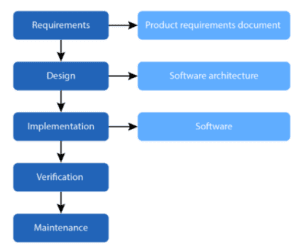
Waterfall Model
Definition:
The waterfall model is the oldest and most basic of all software development life cycle (SDLC) methodologies.
It breaks down the entire software development process into separate phases, with each phase starting only when the previous one finish. Each stage has its project plan and relies on the information from the preceding stage. The primary stages of this model include requirement gathering and analysis, system design, implementation, testing, deployment, and launch.
The waterfall model has common practice usage in software development because it is easy to plan and manage. The process has meticulous documentation, and the processes and outcomes of each stage have precise definitions.
Benefits:
- No overlapping process
- Easy to define key points
- Effortless task prioritizing
- Easy development/ budget/time planning
Disadvantages:
- Product integration starts at the very end process
- No possible problems identification beforehand
- Not scalable and trackable process
- Problematic mid-lifecycle scope adjustments
- High-risk and unguaranteed quantity
Use Case:
- Suited for smaller or middle-size projects with transparent requirements
- Not for complex/time-consuming/changing and object-oriented project model s
2. V-shaped Model
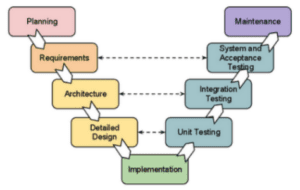
V-shaped Model
Definition:
The V-shaped SDLC model is an extension of the waterfall model, where testing and development stages occur in parallel. Each testing stage corresponds to a development stage and has specific deliverables. The model has a strict plan, and each stage must complete before the next one begins. Testing has a hierarchical order, allowing for early detection of errors.
The V-Model SDLC involves planning testing and development stages in parallel, with verification and validation phases on opposite sides. The model connects through the coding phase.
Benefits:
- Doable and specified results at each level
- One-by-one phase completion
- Early performance testing
- User-friendly and uncomplicated
- Simple project management and result tracking
Disadvantages:
- Inflexible
- Relatively high risks
- Unsupported phase iteration
- Difficult real-time handling
The ideal choice for V models is when:
Use Cases:
- Compact and easily delineated projects
- Qualified software engineers with available testers
- Thorough examination projects
- Exhaustive available technical resources
3. Iterative Incremental Model
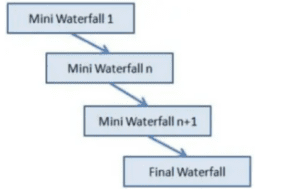
Iterative Incremental Model
Definition:
Iterative development is a software development life cycle approach that begins with a simplified implementation and gradually adds more complexity and features until the final product is complete. In essence, it involves breaking down the development of a large application into smaller parts.
Benefits:
- An early project working version
- Inexpensive changes to the implementation. One disadvantage:
Disadvantages:
- Repetitive processes
- Quick resources depletion
Use Case:
- The Rational Unified Process (RUP) is an instance of an Iterative model that of IBM’s Rational Software division. RUP is a process product that aims to increase team productivity for various projects and organizations.
4. Spiral Model (SDM)
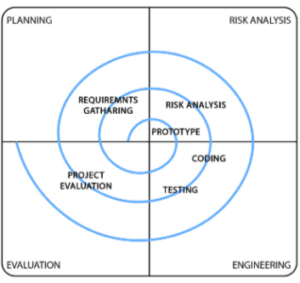
Spiral Model
Definition:
The spiral model is a favored SDLC model for software development because it effectively mitigates risks.
Benefits:
- Flexible adjustability to changing requirements
- Wide prototypes practicality
- Early system delivery
- Thorough risk management
Disadvantages:
- Complex management
- Costly for small or low-risk projects because of o change implementation
- Indefinite continuation
- Unforeseeable project end
- Exhaustive documentation support for minuscule stages
Here are some scenarios where the spiral model is especially fitting:
Use Case:
- Projects with a limited budget and compulsory risk evaluation
- Unsure project requirements
- High-risk level ventures
- Complex assignments’ requirements
- Long-lasting and changing projects
- Customer-centric ventures
5. Big Bang Model
- High-risk level ventures
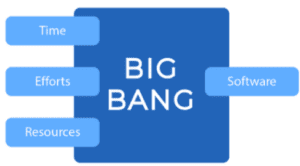
Big Bang Model
Definition:
Unlike other software development models, this model has no set process and only requires starting the project right away, even without clear customer requirements. Usually, only one or two developers work on the project, saving time and cost for small projects.
Benefits:
- No required planning
- Few needed resources
- Simple and flexible
- Fast product delivery
Disadvantages:
- Too easy
- High-risk misunderstanding
- Expensive trials and errors process
- Restarts
In these cases, the use of the Big Bang model will be the most beneficial.
Use Case:
- Small and practical projects
- Agile and lean developer team (1 or 2)
- Undefined release date
6. Agile Model
The Agile model’s popularity is increasing due to its flexibility and adaptability, making it suitable for the following cases:
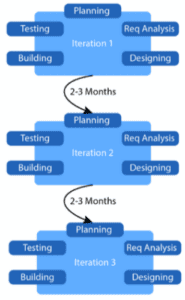
Agile Model
Benefits:
- Time-efficient and cost-efficient for previous go-backs
- Development flexibility
- Brief and well-defined iterations
- Minimized project risks
- Quick release of functional product prototype
- Minimized resource requirements
- Enhanced teamwork and cross-training
Disadvantages:
- Immeasurable final quality check
- Incompatible new modifications with the developed framework
- High-requirement development team: expertise and customer-centric
- Belated final product delivery
- Customer-dependent
Use Case:
- Heavy focus on risk management
- Project Freedom
Right SDLC Model Choice:
Here are the key factors to consider when selecting the appropriate SDLC model for your development project:
- The size and expertise of your team
- The required technology
- Team location
- The project’s type and scope
- Risk management and quality assurance need
Conclusion
In conclusion, the evolution of SDLC has brought about various models that offer unique approaches to software development. From the basic waterfall methodology to the more adaptable Agile model, each approach has its strengths and weaknesses depending on the project requirements and team capabilities.
Ultimately, the success of any software development project hinges on selecting the most appropriate SDLC model, taking into account factors such as team size, necessary technology, project type, and the need for risk management and quality assurance.
We hope this article has provided valuable insights into the available SDLC models and has helped you in selecting the right approach for your next software development project.
If you require additional information on the subject, CMC Japan with 30 years of experience and 2200 skilled employees will be happy to help.
>> REGISTER FOR CMC GLOBAL’S FREE CONSULTATION ON SOFTWARE DEVELOPMENT CYCLE Contact us for further consultation!



